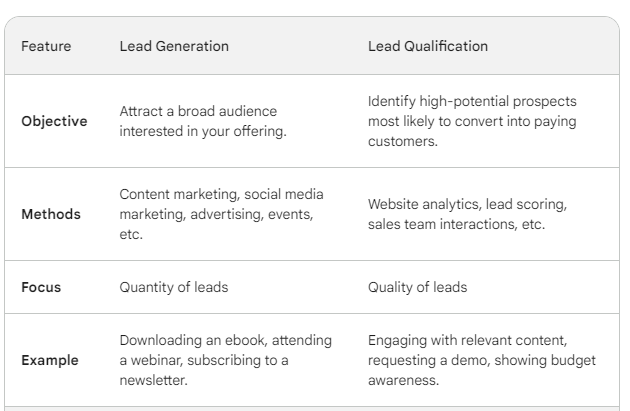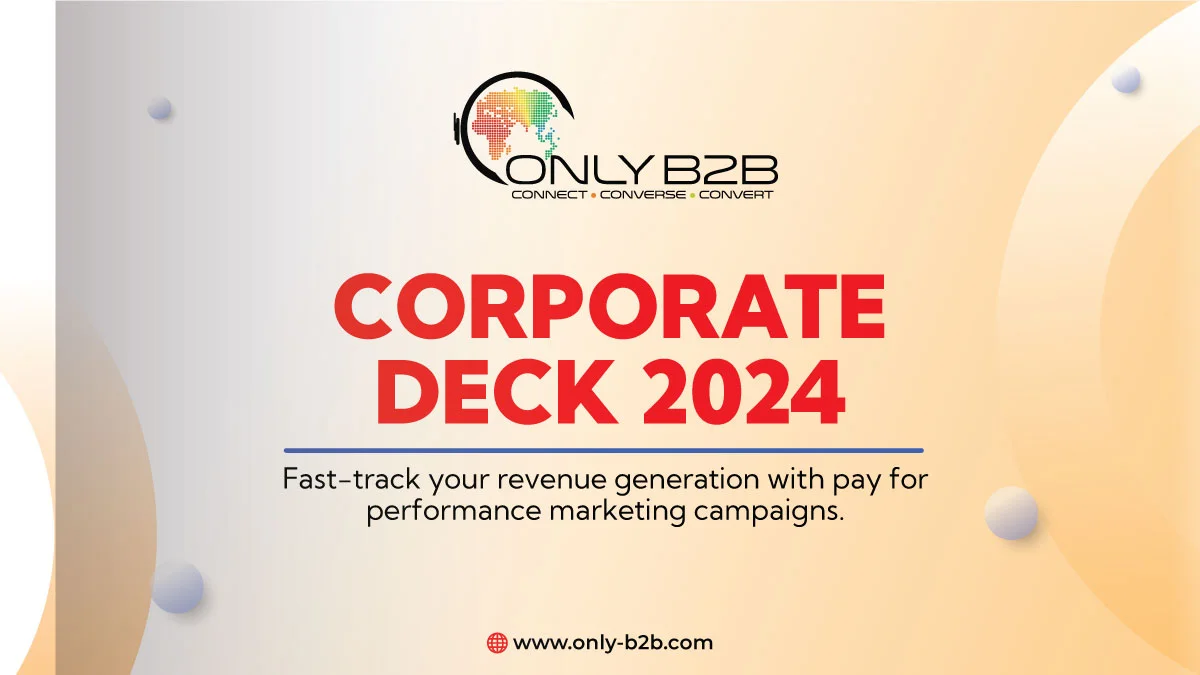
“The only metric that matters in marketing is how many qualified leads you generate every month.”
– Seth Godin, Marketing Author and Entrepreneur
Generating qualified leads is the heart of lead generation and contributes to your bottom line i.e. revenue.
But there are a lot of factors littering the path of lead conversion [time, sales, team, and more]. So, drawing the straight line between the new lead to revenue is the uphill task.
And what creates the curves and turns in the journey is- marketers and salespeople focusing on the vanity metrics like:
- Impressions and clicks.
- Outreach volume (calls, emails, social media)
- Session duration and bounce rate.
These metrics are good to have, but they don’t talk much about the very thing i.e. lead generation or rather lead qualification. Generic mass leads are non-real for driving results.
But generating qualified leads isn’t – because the number of qualified leads is the most immediate result of your effective B2B lead generation strategy or tactics.
However, lead generation and lead qualification are often used interchangeably- they represent distinct yet interconnected stages within the marketing and sales funnel.
Understanding the lead generation vs lead qualification is crucial to smoothen your sales process and maximize conversions.
So, let’s get on:
Lead Generation vs Lead Qualification: The Dynamic Duo of Sales Success
Defining Lead Generation and Lead Qualification
Lead Generation:
This refers to the initial process of attracting potential customers who might be interested in your products or services. Generating a mass of unqualified leads is like taking a scenic detour.
While employing various marketing tactics brings you closer to your destination (closing deals). It includes -aiming to raise brand awareness, generate initial engagement, and capture contact information that allows for further nurturing.
Lead Qualification:
Here’s where you refine your efforts by identifying the most promising leads from the maze of leads generated. This process involves assessing a lead’s fit for your offerings based on specific criteria.
Qualified leads demonstrate a greater potential to convert into paying customers, making them more valuable for your sales team to pursue.
Gartner research from 2023 suggests that only 25% of leads are qualified, signifying the importance of effective lead qualification processes to maximize ROI.
Investing in unqualified lead can be a major drain on your sales team’s time and energy, ultimately impacting your return on investment (ROI).
Must Read: Generate More Qualified Leads with MQL
Understanding the Key Differences Between Lead Generation and Lead Qualification

While both lead generation and lead qualification contribute significantly to your sales funnel, they serve distinct purposes:
Objective:
Lead generation focuses on quantity, aiming to attract a large pool of potential customers. Lead qualification, on the other hand, prioritizes quality, identifying the most promising leads with a higher conversion potential.
Methods:
Lead generation utilizes various marketing strategies, including content marketing (blogs, ebooks, white papers), social media marketing, advertising campaigns, events (webinars, conferences), and partnerships with complementary businesses.
Lead qualification involves website analytics, lead scoring based on specific criteria, marketing automation tools that track user behavior, and interactions with your sales team.
Focus:
Lead generation efforts prioritize attracting a broad audience who might be somewhat familiar with your industry or have a general need that your solution could address.
Lead qualification focuses on identifying leads who exhibit specific characteristics that indicate a strong fit for your offerings.
These characteristics could include their industry, company size, budget constraints, decision-making authority, and the specific challenges they face that your solution can address.
Must Read: Ways to Generate Qualified B2B Sales Leads
Practical scenarios of Lead Generation vs Lead Qualification: Highlighting the Distinction
Let’s illustrate the differences between lead generation and lead qualification with some practical scenarios:
Scenario 1: Lead Generation
Imagine you run a social media marketing agency. You create an informative blog post on “The 5 Social Media Trends You Need to Know in 2024.” This content attracts a large audience of businesses interested in social media marketing, generating leads who download the blog post in exchange for their email addresses.
This is a classic example of lead generation, as it captures the attention of a broad audience with a relevant piece of content.
Scenario 2: Lead Qualification
Following the blog post download, you segment your leads based on their website traffic sources. You identify a particular lead who works for a company in your target industry (e-commerce) and has visited your website pages specifically related to social media advertising services.
This indicates a deeper level of interest compared to someone who simply downloaded the general blog post. This lead is now considered qualified, as they demonstrate a higher potential for conversion due to their specific needs and industry fit.
Must Read: 17 Types of Crazy Lead Generation Methods
The Synergy Between Lead Generation and Lead Qualification
These terms are distinct, while lead generation and lead qualification when implemented strategically together accelerates your lead funnel. Here’s how they contribute to successful sales:
Lead Generation Feeds the Funnel:
A robust lead generation strategy ensures a smooth flow of potential customers entering your sales funnel. By employing various marketing tactics, you attract a broad audience and capture their interest.
Lead Qualification Optimizes the Funnel:
Lead qualification is like eliminating the hurdles in the success path, identifying the most promising leads from the generated pool.
This allows your sales team to focus their efforts on leads with a higher likelihood of converting, maximizing their efficiency and productivity.
Must Read: How to Qualify Inbound Leads
Beyond the Basics: Advanced Lead Qualification Techniques
In today’s data-driven marketing landscape, lead qualification goes beyond simple demographics. Here are some advanced techniques to further refine your efforts:
Lead Scoring:
Assign points to specific lead behavior based on their interaction with your marketing materials (e.g., downloading white papers, visiting product pages, attending webinars).
Leads with a higher score demonstrate a stronger interest and are prioritized for sales outreach.
According to Forrester: Companies that implement lead scoring see a 73% increase in lead quality.
Lead scoring helps you concentrate your sales efforts and resources towards high quality leads, directing you straight to the successful sales.
Progressive Profiling:
Gather additional information about leads through website forms, landing pages, and email marketing campaigns. This allows you to build a more comprehensive profile of each lead, further qualifying their needs and decision-making process.
Marketing Automation:
According to Marketo, marketing automation can generate an average ROI of 5800%.
Marketing Automation is like your 24X7 assistant that tracks and guide prospect to conversion.
Leverage marketing automation tools to track user behavior, segment leads based on specific criteria, and nurture them with relevant content based on their interests and qualifications.
But how to determine which lead is eligible for pursuing? Let’s learn
Must Read: 6 Best Strategies for Targeted Lead Generation
Matching Needs and Solutions:
Let’s talk about the qualification criteria:
Technical Requirements:
During qualification, assess the potential customer’s specific IT infrastructure, software needs, and technical capabilities to ensure compatibility with your SaaS offering.
Budget and Decision-Making Authority:
Understand the prospect’s budget constraints and decision-making process. Identify key decision-makers within the organization and tailor your communication accordingly.
Pain Points and Challenges:
Uncover the prospect’s specific IT challenges and pain points. Demonstrate how your SaaS solution can address them directly, offering a measurable return on investment (ROI).
Engagement and Intent:
- Website and Content Engagement: Analyze how your leads interact with your website and content. Monitor metrics like page visits, time spent on specific pages, and downloaded resources to assess their level of interest and engagement.
- Response to Calls to Action: Track how leads respond to your calls to action (CTAs), such as requesting a free trial, scheduling a demo, or downloading a white paper. High engagement with CTAs indicates a higher level of interest and qualification.
- Sales Team Interactions: Equip your sales team with effective questioning techniques to uncover the prospect’s specific needs, level of urgency, and decision-making timeline. This information helps assess their qualification for your SaaS.
Must Read: Quality Vs Quantity Lead Generation: Who Wins The Race?
Real Examples:
Let’s delve into the lead generation and lead qualification strategies of the successful brands:
Content Marketing:
- HubSpot: This inbound marketing and sales software company built their brand and attracted leads through high-quality blog content, ebooks, and webinars. Their “Inbound Marketing Blog” is consistently ranked among the top marketing blogs globally, attracting millions of visitors and generating qualified leads.
Webinars and Events:
- Zoom: The video conferencing platform, Zoom, regularly hosts webinars and online events featuring industry experts discussing remote work strategies and best practices. These events attract potential customers, showcase Zoom’s capabilities, and generate leads for their sales team.
Social Media Marketing:
- Canva: The graphic design platform, Canva, uses Instagram to showcase their product’s capabilities and user-generated content. This visual approach attracts potential customers, particularly those in creative fields, and demonstrates the platform’s ease of use.
By implementing a robust lead generation strategy alongside effective lead qualification practices, you can build a streamlined sales funnel that attracts high-quality leads, optimizes conversion rates, and ultimately fuels your business growth. Remember, it’s not about the quantity of leads, but the quality of the relationships you nurture.
Embark on your sales journey with lead generation and make the lead qualification your guiding light, leading you to securing paying customers- elevating your revenue and ROI.
Must Read: How to Improve Lead Quality?

Vikas Bhatt is the Co-Founder of ONLY B2B, a premium B2B lead generation company that specializes in helping businesses achieve their growth objectives through targeted marketing & sales campaigns. With 10+ years of experience in the industry, Vikas has a deep understanding of the challenges faced by businesses today and has developed a unique approach to lead generation that has helped clients across a range of industries around the globe. As a thought leader in the B2B marketing community, ONLY B2B specializes in demand generation, content syndication, database services and more.


